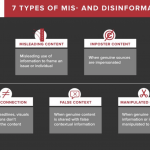 Stop calling it Fake News, 7 types of mis- and disinformation:
Stop calling it Fake News, 7 types of mis- and disinformation:
https://hkspolicycast.org/stop-calling-it-fake-news-6c86f9647e63
A typology for fake news:
Edson C. Tandoc Jr., Zheng Wei Lim & Richard Ling (2017): Defining “Fake News”, Digital Journalism, DOI: 10.1080/21670811.2017.1360143
To link to this article: http://dx.doi.org/10.1080/21670811.2017.1360143
Then consider the following. (Thanks Dan Rather!)
1. Understand that trusting a news outlet doesn’t mean they’re perfect — no one’s perfect. It means they tell you when they screw up.
2. Don’t rely on just one news outlet.
3. Don’t rely on just the news to understand an issue. Read books. Find the experts. Find out how the issues are discussed outside of news.*
4. If you find yourself agreeing with everything your news outlet says, you’re doing it wrong. If your news doesn’t challenge you, challenge your news.
5. Find a commentator whose politics differ from yours.… If you can’t find such a person, maybe the media is not the problem.
6. Remember that what the news tells you is far less important than what they decide to talk about in the first place.
Rather added closing words in the video.
“The true test of trustworthy journalism isn’t that they never make mistakes. It’s whether they’re willing to challenge the powers that be on behalf of those without power.”
https://www.washingtonpost.com/news/arts-and-entertainment/wp/2018/04/04/critics-of-dan-rathers-fake-news-tips-brought-up-his-past-but-the-points-are-pretty-solid/?utm_term=.80344d52acbd
*This echos this fascinating summary of a great experiment. The whole post is awesome, but this is from #2.

- Check for previous work
- Go upstream to the source
- Read laterally
- Circle back
